Cesspools in Hawaii
- Background
- Region 9 UIC Inventory Form
- Properly Abandon and Close a Large-Capacity Cesspool
- Hawaii State Department of Health Wastewater Branch
- Enforcement and Compliance
Background
Cesspools are used throughout Hawaii for the disposal of untreated sanitary waste. Discharge of raw, untreated sewage to a cesspool can contaminate oceans, streams and groundwater by releasing disease-causing pathogens and nitrates. Pathogens found in untreated sewage can impact human health by contaminating drinking water or waters used for swimming. Nitrates can damage land or aquatic ecosystems including coral reefs. Groundwater provides approximately 95% of all domestic water in Hawaii.
Most cesspools in Hawaii serve only single-family residences and are not regulated by EPA. However, large-capacity cesspools (LCCs) are subject to EPA’s Underground Injection Control (UIC) regulations, which required all existing large-capacity cesspools to be closed by April 5, 2005. The regulations do not allow for a waiver or extension of the deadline.
Visit the Large-Capacity Cesspools page to learn more and find out if you own or operate a large-capacity cesspool.
Region 9 UIC Inventory Form
Large-capacity cesspools are considered Underground Injection Control (UIC) wells, and owners and operators of large-capacity cesspools must submit inventory information to EPA. You can use this online form or download Form 7520-16: Inventory of Injection Wells and mail it to the Region 9 LCC Coordinator (R9_LCC_coordinator@epa.gov).
If you need assistance submitting inventory information, please do not hesitate to contact the Region 9 LCC Coordinator (R9_LCC_coordinator@epa.gov).
Properly Abandon and Close a Large-Capacity Cesspool
All owners and operators must properly abandon and close their large-capacity cesspool(s). If you are an owner or operator of a large-capacity cesspool you should contact the Hawaii State Department of Health (HDOH) Wastewater Branch (see State Resources, above-right) for guidance on replacing the large-capacity cesspool with a State-approved wastewater system.
To document proper closure of a large-capacity cesspool that receives 1,000 gallons per day (gpd) or less, you must submit a completed and signed Backfilling Final Completion Report. If the large-capacity cesspool receives more than 1,000 gpd, then you need to contact HDOH/Safe Drinking Water Branch, Underground Injection Control Program (see 'State Resources, above-right) for proper closure instructions.
All documentation demonstrating large-capacity cesspool abandonment and closure should also be submitted to the Region 9 LCC Coordinator (R9_LCC_coordinator@epa.gov).
Hawaii State Department of Health Wastewater Branch
There are approximately 88,000 cesspools in Hawaii; most of which are small-capacity cesspools. Property owners and operators must comply with all federal and state requirements for cesspools.
The Hawaii State Department of Health (HDOH) Wastewater Branch oversees and permits all onsite wastewater systems, including cesspools. HDOH regulations require that cesspools of any size be upgraded, converted, or closed by January 1, 2050.
Enforcement and Compliance
EPA's enforcement activities are designed to investigate and bring cases against individuals or facilities found in violation of the Safe Drinking Water Act's UIC regulations. Regulated entities found in violation may face an enforcement action and fines. EPA is authorized to issue administrative orders requiring compliance and assessing an administrative civil penalty of up to $28,619 for each day of each violation, up to a maximum penalty of $357,729, against an owner or operator of a large-capacity cesspool that violates the Safe Drinking Water Act.
EPA Region 9 has entered into Consent Agreements with a number of regulated entities in Hawaii, including public agencies, businesses and residential facilities, to address violations of the large-capacity cesspool requirements. To date, EPA has assessed around $5.6 million in civil penalties and monitored the closure of over 3,902 large-capacity cesspools in the State.
EPA is authorized to issue compliance orders and/or assess penalties to violators of the Safe Drinking Water Act’s large-capacity cesspool regulations. However, regulated entities who voluntarily discover, promptly disclose, and expeditiously close a large-capacity cesspool may be eligible for a reduction of any civil penalties that otherwise might apply.
Information on how to self-disclose potential large-capacity cesspool violations is available at EPA's eDisclosure.
Public Notice
Compliance Alert
Alert
Tips and Complaints
To submit a large-capacity cesspool-related tip or complaint, call the Tip and Complaint Hotline at (415) 947-4510 or Report Environmental Violations.
Contacts
See Also: Region 9 UIC Contacts
Resources
- Underground Injection Well Registration Form
- LCC Backfill Completion Report
- Hawaii Cesspool Administrative Orders
- Underground Injection Control in EPA Region 9

